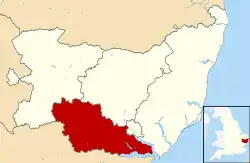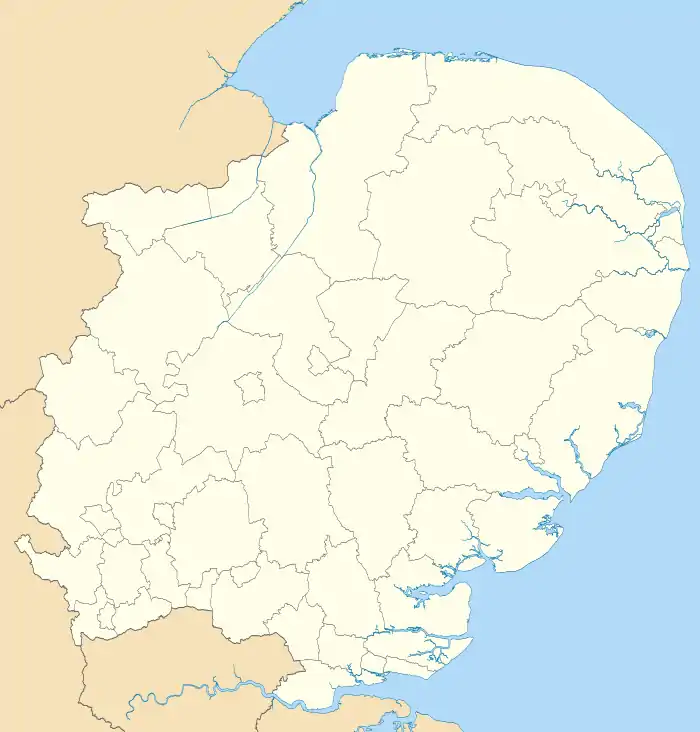Babergh District
Babergh District | |
|---|---|
 Babergh shown within Suffolk | |
| Sovereign state | United Kingdom |
| Constituent country | England |
| Region | East of England |
| Non-metropolitan county | Suffolk |
| Status | Non-metropolitan district |
| Admin HQ | Ipswich |
| Incorporated | 1 April 1974 |
| Government | |
| • Type | Non-metropolitan district council |
| • Body | Babergh District Council |
| • Leadership | Alternative – Sec.31 (Conservative) |
| • MPs | James Cartlidge |
| Area | |
| • Total | 229.8 sq mi (595.2 km2) |
| • Rank | 60th (of 296) |
| Population (Census 2021) | |
| • Total | 92,300 |
| • Rank | 257th (of 296) |
| • Density | 400/sq mi (160/km2) |
| • Ethnicity | 98.7% White |
| Time zone | UTC0 (GMT) |
| • Summer (DST) | UTC+1 (BST) |
| ONS code | 42UB (ONS) E07000200 (GSS) |
| OS grid reference | TM021429 |
| Website | www |
Babergh District (pronounced /ˈbeɪbə/, BAY-bə[1]) is a local government district in Suffolk, England. Primarily a rural area, Babergh contains two towns of notable size: Sudbury, and Hadleigh, which was the administrative centre until 2017.[2] Its council headquarters, which are shared with neighbouring Mid Suffolk, are now based in Ipswich.[3][4]
The district was formed on 1 April 1974 by the merger of the borough of Sudbury, Hadleigh Urban District, Cosford Rural District, Melford Rural District and Samford Rural District. The district did not have one party of councillors (nor a formal coalition of parties) exercising overall control until 2015.
Babergh's population size has increased by 5.2%, from around 87,700 in 2011 to 92,300 in 2021[5] and covers an area of approximately 230 square miles (600 km2).[6]
It is named after the Babergh Hundred, referred to in the Domesday Book of 1086, although it also covers the hundreds of Cosford and Samford. The southern boundary of the district is marked almost exclusively by the River Stour, which also forms the border with Essex, and it is separated from East Suffolk by the River Orwell. It also neighbours the district of Mid Suffolk.
'Constable Country' is cognate with a large tract of Babergh: drawing visitors to the conservation area Dedham Vale and the well-preserved villages of Long Melford, Lavenham and Kersey for painting, agricultural and architectural history, produce such as fruit, vegetables, cider, cheese and meat, shops, accommodation, restaurants and tea rooms.
In 2011, Babergh and Mid Suffolk District Councils began working together, with one, fully integrated staff structure.[7]
Politics
Elections to the district are held every four years. Until 2019, 43 councillors were elected from 26 wards, since that date the council consists of only 32 councillors from 24 wards. From the first election in 1973 until 2015 no party won an overall majority on the council, but after the 2015 election, the Conservative party gained a large majority. After this election the council was composed of the following councillors:
| Year | Conservative | Independent | Liberal Democrat | Labour | Greens | UKIP |
|---|---|---|---|---|---|---|
| 2015 | 31 | 8 | 3 | 1 | 0 | 0 |
In 2017 a by-election resulted in the loss of one Conservative and gain of one Labour councillor.
In May 2017 Babergh adopted the Leader/Cabinet governance model and, since January 2018, the leader is Cllr John Ward.
For the 2 May 2019 election, following a boundary review, the number of councillors was reduced to 32 elected from 24 wards and at the election the district reverted to No Overall Control, with the following councillors elected:[8]
| Year | Conservative | Independent | Liberal Democrat | Labour | Greens |
|---|---|---|---|---|---|
| 2019 | 15 | 8 | 3 | 2 | 4 |
Suffolk County Council Electoral Divisions in Babergh
| No. | Division | Councillor |
|---|---|---|
| 1 | Belstead Brook | Christopher Hudson |
| 2 | Cosford | Robert Lindsay |
| 3 | Great Cornard | Peter Beer |
| 4 | Hadleigh | Mick Fraser |
| 5 | Melford | Richard Kemp |
| 6 | Peninsula | Simon Harley |
| 7 | Samford | Georgia Hall |
| 8 | Stour Valley | James Finch |
| 9 | Sudbury | Jessie Carter |
| 10 | Sudbury East and Waldingfield | Philip Faircloth-Mutton |
References
- "Babergh District Council – Summary". Archived from the original on 26 January 2010.
- Estimates of Total Populations of Areas of Suffolk Archived 19 December 2008 at the Wayback Machine Suffolk County Council
- "Contact Us » Babergh Mid Suffolk". babergh.gov.uk.
- Geater, Paul. "Babergh and Mid Suffolk councils set to move to Ipswich in September". Ipswich Star. Archived from the original on 12 February 2020. Retrieved 6 February 2018.
- "How the population changed in Babergh, Census 2021 – ONS". ons.gov.uk. Retrieved 9 November 2022.
- "District population 2011". Neighbourhood Statistics. Office for National Statistics. Archived from the original on 12 October 2016. Retrieved 15 August 2016.
- "One Council » Babergh Mid Suffolk". midsuffolk.gov.uk. Retrieved 27 January 2022.
- "Babergh District Councillors". Babergh and Mid Suffolk District Councils. 14 June 2019. Retrieved 14 August 2019.
